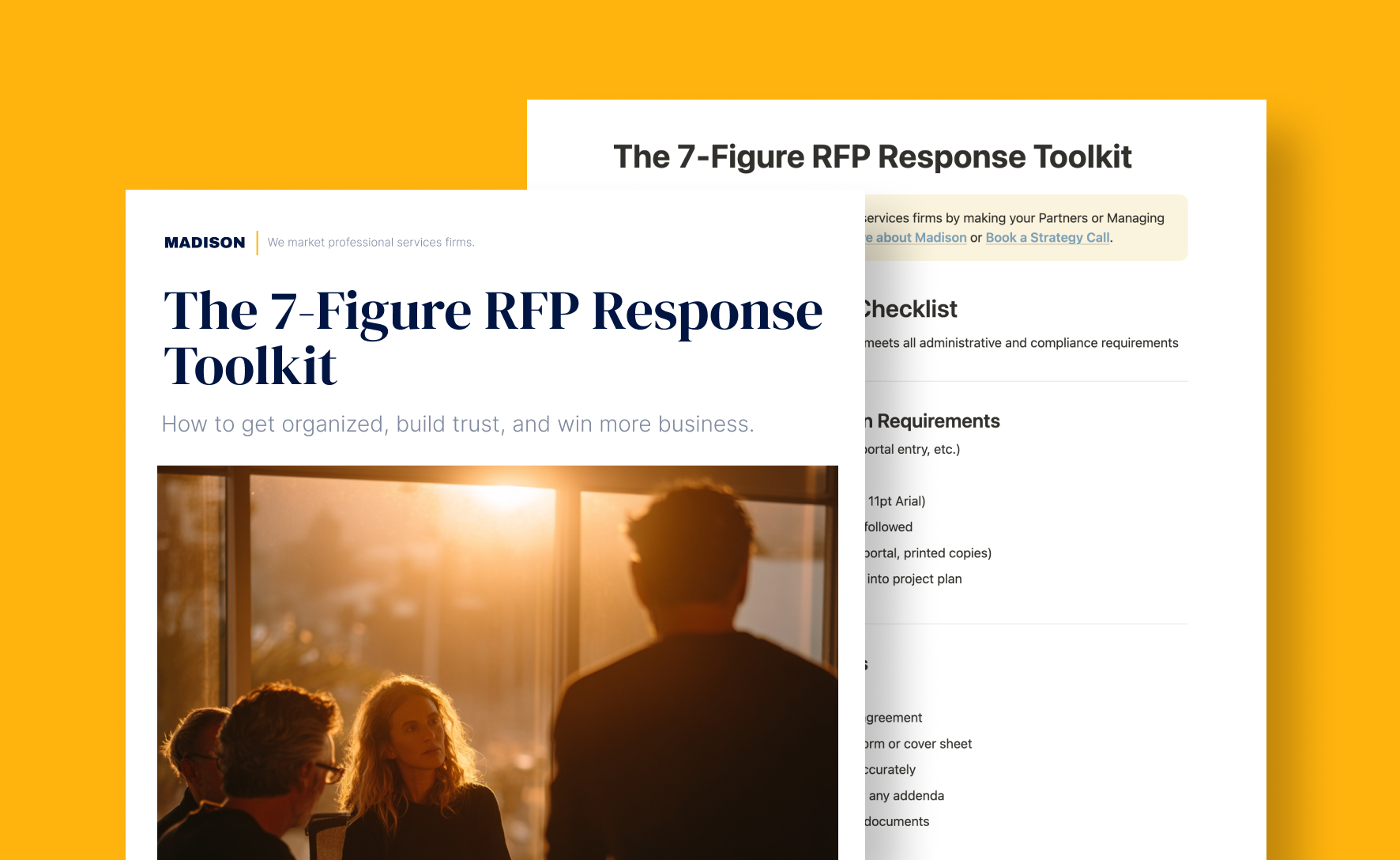In this Article:
We recently helped a client win a seven-figure RFP. It’s not the first time. Over the years, we’ve supported dozens of proposal efforts. Some we’ve won, some we’ve lost.
The stakes are high in these deals. The competition is often fierce. Timelines are tight. Procurement processes are rigid. And in many cases, you’re going up against an incumbent or preferred vendor with a head start.
But after watching dozens of firms go through this process, we’ve developed a few strong beliefs about what separates winning proposals from the rest.
If you’ve got your eye on 6- or 7-figure deals, here’s what you need to know.
Handle the “Boring” Stuff First
Most RFPs include a host of seemingly minor requirements. Formatting instructions. Conflict of interest disclosures. Diversity reporting. Insurance levels. Data security protocols. Boilerplate resumes. You get the idea.
It’s tempting to ignore these until the last minute. Who cares about your SOC 2 certification when you’re proposing a million-dollar innovation strategy?
Procurement does.
The first pass on any RFP is a compliance review. If you miss enough checkboxes, your proposal might get filtered out before any of the business stakeholders ever see it.
Winning firms know this. They get the administrative details out of the way early so they can focus on what really matters later.
Tip: Create an RFP “compliance checklist” early and knock it out first. It’ll make your life easier and prevent last-minute scrambling.
Treat Discovery Like Gold
If the RFP process includes stakeholder interviews, take them seriously.
Yes, it’s unpaid time. Yes, you may be asked to share early thinking before you’ve won the work. But these conversations are your best shot at understanding what’s really going on behind the RFP.
You’ll uncover things like:
- Competing priorities between departments
- Internal champions (and saboteurs)
- What “success” looks like for different stakeholders
- The unsaid fears driving the project
This is gold. And it’s what allows you to write a proposal that resonates.
Don’t treat discovery like a formality. Treat it like research. Because that’s exactly what it is.
Show That You Listened
The best proposals don’t just offer a solution. They reflect the client’s own language, concerns, and aspirations back to them.
One of the most effective tactics we’ve seen is including verbatim quotes from stakeholder interviews throughout the proposal. For example:
“One stakeholder told us, ‘We need a partner who can help us move fast, but not skip the hard questions.’ Our proposed approach was designed with this tension in mind…”
This isn’t just a rhetorical trick. It signals that you heard them. That you’re attuned to their real goals. That you’re not just throwing your standard playbook at the problem.
Teams notice this. And they reward it.
Don’t Just Say What They Want to Hear
A common mistake is tailoring your proposal so closely to the RFP language that you lose your own voice and perspective.
I get it. You want to win. You want to make it easy for them to say yes.
But you’re being hired to be a trusted advisor. Not a yes-person.
If you believe the approach outlined in the RFP is suboptimal, say so. Respectfully. But clearly.
You can acknowledge the thinking behind their current approach and propose a better alternative. That’s how trust begins.
Besides, in many cases, the RFP was shaped (explicitly or implicitly) by an incumbent vendor. If you just parrot back their thinking, you’ll sound like a weaker version of someone they already know.
Differentiate with integrity. Don’t be contrarian for its own sake. But don’t be afraid to offer a better way.
Don’t Skimp on Project Management
We’ve lost RFPs not because our ideas weren’t strong, but because we glossed over how the engagement would actually unfold.
Clients want to know the specifics:
- What happens after they say yes?
- Who’s doing the work?
- How will you manage scope?
- How will you keep things on track?
You don’t need to include a Gantt chart or overwhelm them with PM-speak. But you do need to show that you’ve thought about delivery.
Outline milestones. Highlight key roles. Explain how issues will be escalated. If you use a proven process (e.g., agile sprints, stage gates), show how it will apply to their context.
This gives clients confidence. And confidence closes deals.
Talk Less About Yourself, More About Them
Another common trap is spending too much of the proposal talking about your firm, your history, your capabilities, and your awards.
Those things matter. But they should be in the appendix.
The body of the proposal should be about the client:
- Their goals
- Their current state
- Their constraints
- Their stakeholders
- Their future
Your case studies, bios, and intro decks are supporting material, not the main event.
Pro tip: Include an appendix with a tight, well-designed 6–12 slide intro deck, team bios, case studies, and certifications. It’s there for the folks who don’t know you yet. But don’t lead with it.
The Scariest Question: “Have You Done This Before?”
This question trips up a lot of firms, especially newer ones or those pivoting into new industries.
Don’t panic. Don’t bluff. Don’t apologize.
Instead, speak directly to the closest proxy. Acknowledge that this exact use case is new for you, but draw on relevant experience. Emphasize:
- Similar clients you’ve helped
- Analogous challenges you’ve solved
- Your ability to ramp up fast through discovery
- Past “firsts” that led to strong outcomes
Being honest about your position (and confident in your ability to deliver) is more credible than pretending to be something you’re not.
Often, a fresh perspective is exactly what the client is looking for.
Don’t Race to the Bottom on Price
In large RFPs, procurement often sets a budget range or ballpark expectations. You want to be within that range. But you don’t need to be the cheapest.
In fact, being the cheapest often hurts you. Clients may assume you’ve misunderstood the scope. That you’re going to change-order them later. That you’re cutting corners.
Some firms intentionally lowball to win the work, then rely on change orders to make it up. Don’t be that firm. It damages trust and signals desperation.
Instead, be transparent. Show your pricing logic. Offer phased approaches if budget is tight. Anchor your price to the outcomes, not just inputs. If they push back, trim scope.
Price isn’t everything. But mis-pricing can lose you the deal, and too low can be as bad as too high.
The Best Time to Influence the RFP Is Before It’s Written
The hardest RFPs to win are the ones you hear about for the first time when the document drops.
By then, the requirements are locked. The relationships are formed. The budget is set. And, often, the incumbent has already helped shape the scope.
To shift the odds in your favor, you want to be the firm that helps shape the RFP.
How? By building relationships before the project exists. Doing small low-risk, or even pro bono projects to build trust. To get on the approved vendor list early. To share relevant thought leadership and frameworks in advance.
It’s not always possible. But when it is, it changes everything.
If you can help a client frame the problem before they write the RFP, you’re in the drivers seat. You get to help set the terms and seed your ideas.
Proposals Are Performances
Responding to an RFP is a chance to demonstrate how you think, how you communicate, and how you operate under pressure.
Don’t just play to win the work. Play to earn trust. If you do that well, you’ll not only increase your win rate, but build a reputation that brings more RFPs to your door.


